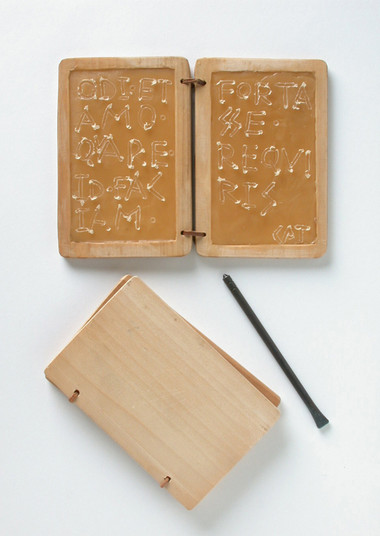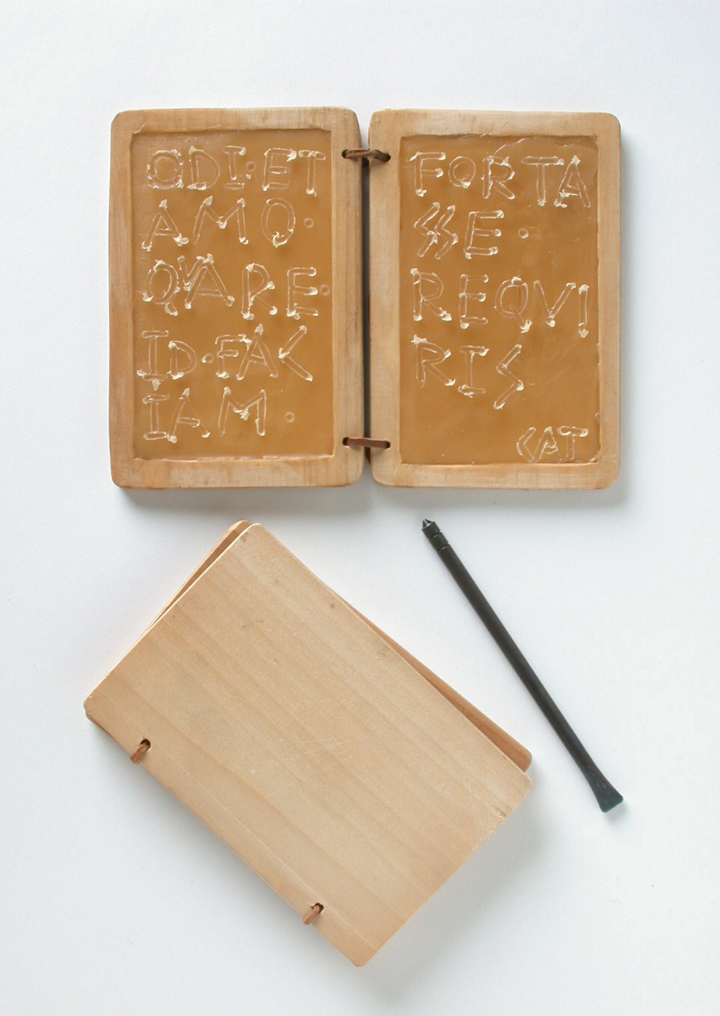Wax Tablet & Stylus, Ancient Rome, Replica
Paper was very expensive in the Roman world. Before the technique of making paper from pulp arrived from China into Europe, paper was made from papyrus reeds or parchment. Papyrus (from which the word paper is derived) was made by weaving reeds to form a sheet and then beating the sheet to create a flat surface. Parchment is made from very fine layers taken from the skins of animals. Both papyrus and parchment were used for books and important documents.
The Romans used writing for other tasks too, such as making lists, leaving instructions and the education of boys. Then, wax tablets were used. These were pieces of wood, tied together so that they could open and shut. Each piece of wood had a shallow recess that was filled with wax and formed the writing surface. A stylus was used to write on the wax surface. The stylus was usually made of iron but sometimes bronze or bone. One end was pointed for writing and the other end was flattened for erasing so that the wax could be used again.
A wax tablet was most commonly formed of two pieces of wood and was called a diptych. Sometimes tablets were made of three pieces, called a triptych, or more, called polyptychon.
The Romans used writing for other tasks too, such as making lists, leaving instructions and the education of boys. Then, wax tablets were used. These were pieces of wood, tied together so that they could open and shut. Each piece of wood had a shallow recess that was filled with wax and formed the writing surface. A stylus was used to write on the wax surface. The stylus was usually made of iron but sometimes bronze or bone. One end was pointed for writing and the other end was flattened for erasing so that the wax could be used again.
A wax tablet was most commonly formed of two pieces of wood and was called a diptych. Sometimes tablets were made of three pieces, called a triptych, or more, called polyptychon.

Wax Tablet Length:15cm

Wax Tablet Length:15cm

Paper was very expensive in the Roman world. Before the technique of making paper from pulp arrived from China into Europe, paper was made from papyrus reeds or parchment. Papyrus (from which the word paper is derived) was made by weaving reeds to form a sheet and then beating the sheet to create a flat surface. Parchment is made from very fine layers taken from the skins of animals. Both papyrus and parchment were used for books and important documents.
The Romans used writing for other tasks too, such as making lists, leaving instructions and the education of boys. Then, wax tablets were used. These were pieces of wood, tied together so that they could open and shut. Each piece of wood had a shallow recess that was filled with wax and formed the writing surface. A stylus was used to write on the wax surface. The stylus was usually made of iron but sometimes bronze or bone. One end was pointed for writing and the other end was flattened for erasing so that the wax could be used again.
A wax tablet was most commonly formed of two pieces of wood and was called a diptych. Sometimes tablets were made of three pieces, called a triptych, or more, called polyptychon.
The Romans used writing for other tasks too, such as making lists, leaving instructions and the education of boys. Then, wax tablets were used. These were pieces of wood, tied together so that they could open and shut. Each piece of wood had a shallow recess that was filled with wax and formed the writing surface. A stylus was used to write on the wax surface. The stylus was usually made of iron but sometimes bronze or bone. One end was pointed for writing and the other end was flattened for erasing so that the wax could be used again.
A wax tablet was most commonly formed of two pieces of wood and was called a diptych. Sometimes tablets were made of three pieces, called a triptych, or more, called polyptychon.




















